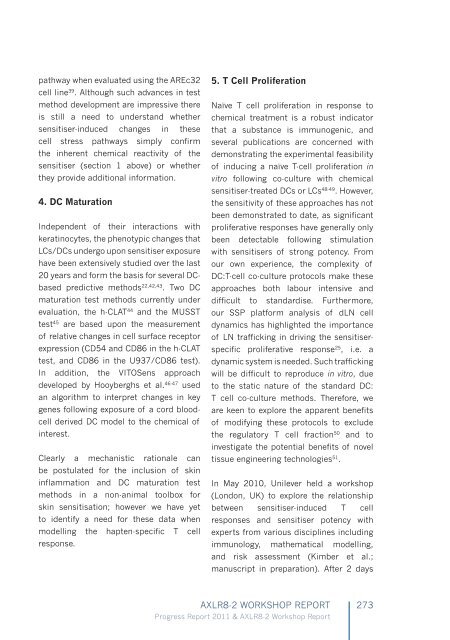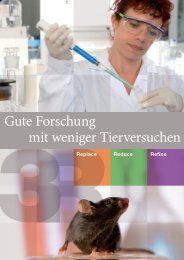You also want an ePaper? Increase the reach of your titles
YUMPU automatically turns print PDFs into web optimized ePapers that Google loves.
pathway when evaluated using the AREc32<br />
cell line 39 . Although such advances in test<br />
method development are impressive there<br />
is still a need to understand whether<br />
sensitiser-induced changes in these<br />
cell stress pathways simply confirm<br />
the inherent chemical reactivity of the<br />
sensitiser (section 1 above) or whether<br />
they provide additional information.<br />
4. DC Maturation<br />
Independent of their interactions with<br />
keratinocytes, the phenotypic changes that<br />
LCs/DCs undergo upon sensitiser exposure<br />
have been extensively studied over the last<br />
20 years and form the basis for several DCbased<br />
predictive methods 22,42,43 . Two DC<br />
maturation test methods currently under<br />
evaluation, the h-CLAT 44 and the MUSST<br />
test 45 are based upon the measurement<br />
of relative changes in cell surface receptor<br />
expression (CD54 and CD86 in the h-CLAT<br />
test, and CD86 in the U937/CD86 test).<br />
In addition, the VITOSens approach<br />
developed by Hooyberghs et al. 46-47 used<br />
an algorithm to interpret changes in key<br />
genes following exposure of a cord bloodcell<br />
derived DC model to the chemical of<br />
interest.<br />
Clearly a mechanistic rationale can<br />
be postulated for the inclusion of skin<br />
inflammation and DC maturation test<br />
methods in a non-animal toolbox for<br />
skin sensitisation; however we have yet<br />
to identify a need for these data when<br />
modelling the hapten-specific T cell<br />
response.<br />
5. T Cell Proliferation<br />
Naïve T cell proliferation in response to<br />
chemical treatment is a robust indicator<br />
that a substance is immunogenic, and<br />
several publications are concerned with<br />
demonstrating the experimental feasibility<br />
of inducing a naïve T-cell proliferation in<br />
vitro following co-culture with chemical<br />
sensitiser-treated DCs or LCs 48-49 . However,<br />
the sensitivity of these approaches has not<br />
been demonstrated to date, as significant<br />
proliferative responses have generally only<br />
been detectable following stimulation<br />
with sensitisers of strong potency. From<br />
our own experience, the complexity of<br />
DC:T-cell co-culture protocols make these<br />
approaches both labour intensive and<br />
difficult to standardise. Furthermore,<br />
our SSP platform analysis of dLN cell<br />
dynamics has highlighted the importance<br />
of LN trafficking in driving the sensitiserspecific<br />
proliferative response 25 , i.e. a<br />
dynamic system is needed. Such trafficking<br />
will be difficult to reproduce in vitro, due<br />
to the static nature of the standard DC:<br />
T cell co-culture methods. Therefore, we<br />
are keen to explore the apparent benefits<br />
of modifying these protocols to exclude<br />
the regulatory T cell fraction 50 and to<br />
investigate the potential benefits of novel<br />
tissue engineering technologies 51 .<br />
In May 2010, Unilever held a workshop<br />
(London, UK) to explore the relationship<br />
between sensitiser-induced T cell<br />
responses and sensitiser potency with<br />
experts from various disciplines including<br />
immunology, mathematical modelling,<br />
and risk assessment (Kimber et al.;<br />
manuscript in preparation). After 2 days<br />
AXLR8-2 WORKSHOP REPORT<br />
Progress Report 2011 & AXLR8-2 Workshop Report<br />
273




